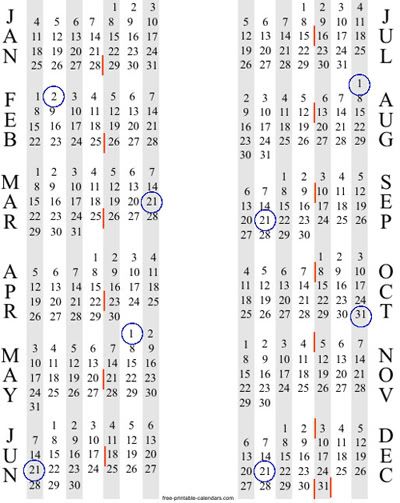Post by Victoria on Oct 7, 2009 3:09:49 GMT
The villagers and Guardians in this roleplay are governed closely by their calendar, which has superstitious and spiritual significance to them.
You aren't expected to memorise this! I know, it's complicated. Just use it for reference.
The counting of years starts for them at about 10,000 BC, and is expressed in roman numerals (century and year). So our "10,000 BC" is their "Year I". The year at which this site begins , "Year LV, Century XMDC" is numerically year 55 of century 116. In our Gregorian calendar, this equates to about 1655.
Each year has 365 days, divided into thirteen months which each contain twenty-eight days, which follow the cycles of the moon (lunar cycles occur over twenty-eight days). The twenty-eight days of each month are separated into four weeks, which start with Sunday and end with Saturday. Thus, the first day of every year is a Sunday, as is the first day of every month.
There are twenty-four hours in each day, and they are referred to by the twenty-four hour clock; i.e., 1:45 am is 1.45 hour and 3:00 pm is 15th hour.
The months each are named in Latin, as per their order. They are:Unumber
Duober
Triaber
Quattuorber
Quinqueber
Sexber
September
October
November
December
Undecimber
Duodecimber
Tredecimber
The days of the week are named after visible astral entities: "Sun" day, "Moon" day, "Mars" day, "Mercury" day, "Jupiter" day, "Venus" day and "Saturn" day. They are:Sunday
Monday
Marday
Mercday
Jupday
Venday
Saturday
Sandwiched between each year is a single day belonging to no week, year, or month. It is called "Cynday", and it honours the North Star, Polaris, which they call Cynos. Every four years there is a leap year, in which a similar day (belonging to no week or month) is inserted between the second and third weeks of Sexbur (thus, between the second Saturday and third Sunday); it is called "Sirday", and honours the bright star Sirius.
There are eight festivals per year, marking the solstices and equinoxes. They are:
Imbolc (5th of Duober) [day of birth]
Ostara (24th of Triaber) [spring equinox]
Beltaine (9th of Quinqueber) [day of life]
Litha (4th of September) [summer solstice]
Lammas (17th of October) [day of plenty]
Mabon (12th of December) [autumn equinox]
Samhain (24th of Undecimber) [day of death]
Yule (19th of Tredecimber) [winter solstice]
Worship days, on which the villagers (and their cats!) fast while the sun is up and do not work, occur each week. The day of the week on which a worship day occurs depends upon which festival was celebrated last. They are:After Imbolc: Saturday
After Ostara: Marday
After Beltaine: Venday
After Litha: Monday
After Lammas: Sunday
After Mabon: Venday
After Samhain: Marday
After Yule: Saturday
The following is a conversion chart from the Julian calendar (which most of us will be used to using) to the calendar used by the villagers of Benevolence; it might help to put times of the year in perspective. The red lines mark where the villagers' month would be ending, and the blue circles mark festival days. Days of the week aren't listed, but recall that the first of each month, week and year begins on a Sunday. December 31st on the Julian calendar is equivalent to the villagers' Cynday.
Need help? Get it here!


